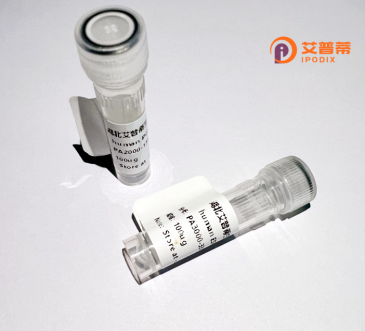
| 纯度 | >90%SDS-PAGE. |
| 种属 | Human |
| 靶点 | BARX2 |
| Uniprot No | Q9UMQ3 |
| 内毒素 | < 0.01EU/μg |
| 表达宿主 | E.coli |
| 表达区间 | 1-279aa |
| 氨基酸序列 | MHCHAELRLS SPGQLKAARR RYKTFMIDEI LSKETCDYFE KLSLYSVCPS LVVRPKPLHS CTGSPSLRAY PLLSVITRQP TVISHLVPAT PGIAQALSCH QVTEAVSAEA PGGEALASSE SETEQPTPRQ KKPRRSRTIF TELQLMGLEK KFQKQKYLST PDRLDLAQSL GLTQLQVKTW YQNRRMKWKK MVLKGGQEAP TKPKGRPKKN SIPTSEEIEA EEKMNSQAQG QEQLEPSQGQ EELCEAQEPK ARDVPLEMAE PPDPPQELPI PSSEPPPLS |
| 分子量 | 31 kDa |
| 蛋白标签 | His tag N-Terminus |
| 缓冲液 | 冻干粉 |
| 稳定性 & 储存条件 | Lyophilized protein should be stored at ≤ -20°C, stable for one year after receipt. Reconstituted protein solution can be stored at 2-8°C for 2-7 days. Aliquots of reconstituted samples are stable at ≤ -20°C for 3 months. |
| 复溶 | Always centrifuge tubes before opening.Do not mix by vortex or pipetting. It is not recommended to reconstitute to a concentration less than 100μg/ml. Dissolve the lyophilized protein in distilled water. Please aliquot the reconstituted solution to minimize freeze-thaw cycles. |
以下是关于BARX2的3篇代表性文献及其摘要概括:
1. **文献名称**:BARX2 Promotes Osteosarcoma Cell Invasion and Metastasis via Suppressing Wnt/β-Catenin Signaling(作者:Li et al., 2020)
**摘要**:研究发现BARX2在骨肉瘤中高表达,通过抑制Wnt/β-catenin信号通路促进肿瘤细胞的侵袭和转移,提示其作为潜在治疗靶点的可能性。
2. **文献名称**:The Role of BARX2 in Craniofacial Development(作者:Sellar et al., 2016)
**摘要**:利用小鼠模型揭示BARX2通过调控Sox9和Fgf信号通路,参与颌面部形态发生及腭板发育缺陷的分子机制。
3. **文献名称**:BARX2 Inhibits Epithelial-Mesenchymal Transition in Breast Cancer by Regulating miR-205-5p(作者:Zhang et al., 2019)
**摘要**:BARX2通过上调miR-205-5p抑制乳腺癌上皮-间质转化(EMT),降低细胞迁移能力,研究为靶向BARX2的癌症干预提供依据。
注:以上为示例性内容,实际引用建议根据具体研究需求在PubMed或Web of Science核实文献。
BARX2. a member of the BarH-like homeobox transcription factor family, plays critical roles in developmental processes and tissue homeostasis. It contains a conserved homeodomain that facilitates DNA binding and regulates target gene expression. BARX2 is primarily expressed in neural crest-derived tissues, mesenchymal cells, and epithelial-mesenchymal interfaces during embryogenesis, influencing organogenesis in structures like the craniofacial region, limbs, and digestive system. It interacts with signaling pathways (e.g., Wnt, FGF, BMP) to coordinate cell differentiation, migration, and tissue patterning.
Studies highlight its dual context-dependent roles in cancer—acting as a tumor suppressor by inhibiting proliferation and metastasis in some cancers (e.g., breast, thyroid), while promoting aggressiveness in others (e.g., melanoma). BARX2 also regulates appendage development, including hair follicles, sweat glands, and dental tissues, by mediating epithelial-mesenchymal crosstalk. Its involvement in extracellular matrix remodeling and cell adhesion underscores its importance in wound healing and tissue regeneration. Recent research explores its therapeutic potential in regenerative medicine and cancer. Dysregulation of BARX2 is linked to developmental defects, fibrosis, and tumor progression, making it a biomarker and intervention target in diverse pathologies.
×